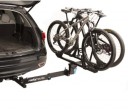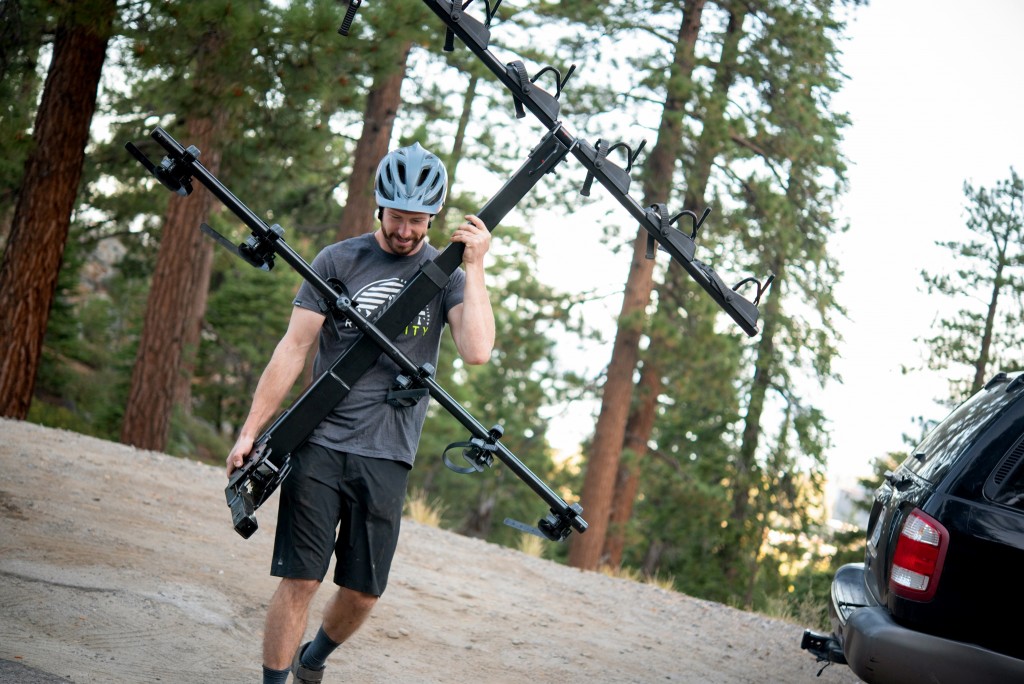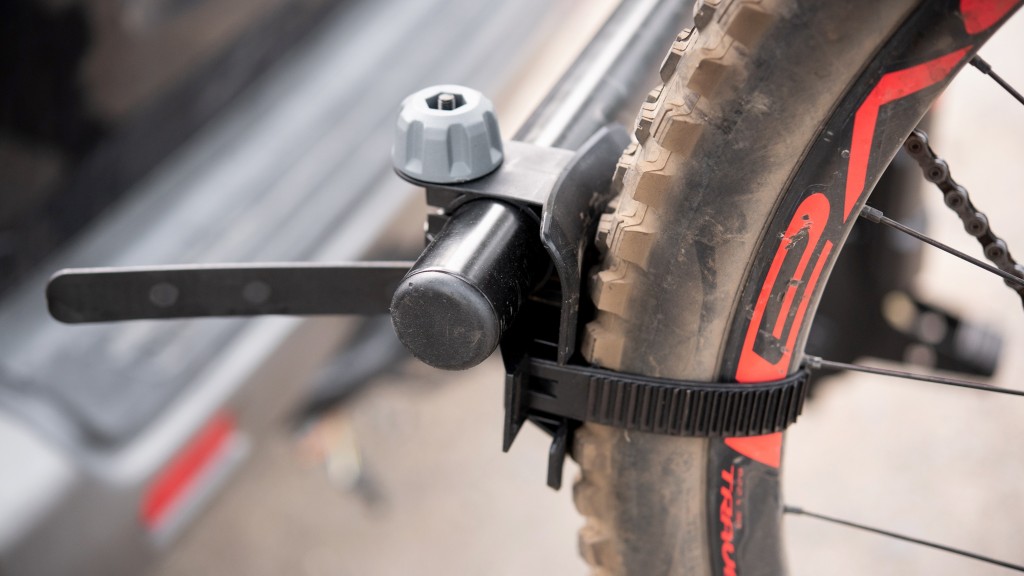Yakima HangOver Review
Our Verdict
Compare to Similar Products
 This Product
Yakima HangOver | |||||
|---|---|---|---|---|---|
| Awards | Best Hitch Rack Under $1000 | Best Bang for the Buck Hitch Rack | Best Swing-Away Rack | Best No Frills, Durable Rack | |
| Price | $799 List Check Price at REI | $639.69 at Amazon | $499.95 at Backcountry | $723.75 at Amazon | $750 List |
Overall Score  |
|||||
| Star Rating | |||||
| Bottom Line | A quality, high-capacity, bike rack that lacks versatility | Versatile and easy to use with an excellent tilt-release function | This impressive rack is sturdy and user-friendly, with a lower price tag than the premium options | If you want a swing-away hitch rack, this is a great option that will allow you to access the back of your vehicle | A rugged hitch-mount rack that folds up for compact storage |
| Rating Categories | Yakima HangOver | Thule T2 Pro-XTR | RockyMounts Mono Rail | RockyMounts BackStage | 1Up USA 2" Heavy Du... |
| Ease of EveryDay Use (20%) | |||||
| Ease of Removal and Storage (20%) | |||||
| Versatility (20%) | |||||
| Security (20%) | |||||
| Ease of Assembly (10%) | |||||
| Durability (10%) | |||||
| Specs | Yakima HangOver | Thule T2 Pro-XTR | RockyMounts Mono Rail | RockyMounts BackStage | 1Up USA 2" Heavy Du... |
| Bike Capacity | 6 | 2 (Up to 4 with add-on) | 2 (Up to 3 with add-on) | 2 | 2 (Up to 4 with add-on) |
| Lock? | Locking hitch pin and security cable | Yes | Yes | Yes | No |
| Rack Weight | 78 lbs 8 oz | 51 lbs | 44 lbs 2 oz | 60 lbs 3 oz | 46 lbs |
| Max Weight Per Bike | 37.5 lbs | 60 lbs | 60 lbs | 60 lbs | 50 lbs |
| Min/Max Wheel Size | n/a | 20" to 29" | 20" to 29" | 20" to 29" | 16" to 29" |
| Max Wheelbase | n/a | 50" or 1,270mm | 50" or 1,270mm | 50" or 1,270mm | 54" or 1,371mm |
| Max Tire Width | n/a | 5" | 5" | 5" | 3.1" |
| Loading Time | |||||
| Other Sizes Available? | Yes, 4 bike version | Yes, 1.25" receiver and rack add-on for 2 additional bikes | Yes, 1.25" reciever, single bike add-on sold separately | No | Yes, single bike version and rack add-on for one additional bike |
| Cross Bar Compatibility | N/A | N/A | N/A | N/A | N/A |
Our Analysis and Test Results
The Yakima HangOver rack is a quality rack that has a relatively narrow range of applications. This is one of only a few racks on the market that can carry as many as six mountain bikes at a time. While it is quite easy to use and feels relatively durable, it is far from the most versatile option out there. It may be a bit of a niche product, but it functions exceptionally well for the right buyer with the right needs.
Performance Comparison
Ease of Everyday Use
The HangOver is easy to use when compared to other racks with high carrying capacity. Due to its weight and size, this is the kind of rack that you'll likely want to keep on your car for the mountain bike season, especially if you ride often. Loading and unloading bikes is quick and easy, and it holds the bikes in a way that prevents bike-on-bike contact.
The Hangover is a hitch-mount rack that holds the bikes vertically, hanging from the crown of a suspension fork. Loading is quite simple even if it is slightly more involved than a tray-style rack. Simply grab the bike on the lower fork leg and seat stay and lift the front end onto the fork cradle by turning the wheel slightly to the right. This does require a little bit of effort and it can be cumbersome with heavier bikes. Once the fork's crown is in the cradle, the rear wheel drops into place on the lower crossbar of the rack. At this point, use the rubber straps to secure the fork crown to the rack and the ratchet system to secure the rear wheel to the lower crossbar. The process is relatively user-friendly, but it is certainly more work than simply dropping a bike onto a tray-style setup and clamping it down.
The fork cradle is a bit simpler than it looks, and the rubberized strap that secures the fork to the rack works well. The ratchet-system that clamps the rear wheel to the rack is a bit more finicky and typically needs two hands to tighten it down. Yakima provides a rope that you can loop through the front wheels if you want to keep them from spinning during transport.
The mast has two height positions so you can adjust it for optimal ground clearance. It also has a tilt feature for easy access to the rear of the vehicle. A pedal at the base of the main mast actuates the tilt function and keeps your hands free to support the weight of the bikes and rack as you lower them.
Ease of Removal and Storage
The HangOver isn't the easiest rack to remove and store. The 6-bike version we tested weighs close to 80 lbs and is a large and somewhat cumbersome shape. For most folks, it will be a two-person job to safely remove this rack from the vehicle and move it into the shed or garage.
In addition to the obvious weight of the rack, it is exceptionally large. It is wide, tall, and bulky. Trying to maneuver this thing through gates or doorways is exponentially more difficult than almost any other rack in our test.
Versatility
The major caveat about this rack is that it only works with suspension forks. This means road bikes, hybrid bikes with rigid forks, BMX bikes, and kids bikes with rigid forks will not work. Even if you primarily mountain bike, having the ability to transport other styles of bikes occasionally is important.
This rack is a great example of a product that does what it does very well. When mounted on a truck or a big SUV, the HangOver is right at home hauling your crew's enduro sleds to the top of a rad downhill. There is no doubt that Yakima delivered a quality product, but it has a narrow range of applications.
On smaller vehicles, including small to small-mid-sized SUVs, the HangOver is simply too large. The mast and upper horizontal bar will protrude significantly above the roofline of your vehicle and stick out wider than your mirrors. To be frank, it looks quite goofy on smaller vehicles. In addition, it only works on vehicles with a 2" receiver. The 1.25" crowd is out of luck.
According to Yakima, the HangOver has a maximum weight capacity of 37.5-lbs per bike. That is a notably low carrying capacity. Most trail and enduro bikes shouldn't have any problems. But downhill bikes, and more importantly E-bikes, regularly weigh significantly more than 37.5-lbs.
Ease of Assembly
The HangOver was reasonably easy and intuitive to assemble. Once you wrestle the exceptionally heavy box to the location where you will slap it together, things get much easier. It is best to assemble the rack on the back of a vehicle.
The rack comes in a few main pieces with separate bags of straps and ratchets brackets that you will install last. There is a base piece that includes the hitch portion as well as the lower mast with the word Yakima printed on it. This is where the bulk of that 80-pound weight lives. Next, there is a lighter and thinner upper portion of the mast that you attach. The horizontal bars need to be attached and then you go about putting the ratchets on.
The assembly took us about 45 minutes to complete. It is a little intimidating when you crack the box open and see all of the parts, but the directions are well-written and the process is more or less intuitive. The North Shore NSR-6 is a very similar vertical-style rack and assembly is far more complicated with a whole lot more nuts and bolts involved.
Security
The HangOver 6 posts a mediocre score in terms of security. The only security feature is a locking barrel that secures the hitch pin. This means that nobody will be able to simply detach the entire rack from your vehicle (without breaking the lock). The hitch pin lock isn't especially meaty, but it is well-designed and low profile.
The bikes are fair game to a thief. Given the design of the HangOver there really was no way for Yakima to provide security features. If you have this rack, we'd recommend purchasing a long, beefy cable lock that can be threaded through all of the bike frames and wheels if you intend to leave them unsupervised for any length of time.
Durability
If this rack is one thing, it is robust. The HangOver is chunky and has a built-to-last look and feel to it. We don't have any serious concerns about the structural integrity of the rack if you abide by the maximum weight suggestion. We can see many folks, sometimes unknowingly, exceeding the weight limit on this rack. The horizontal bars are substantial, but we wouldn't load this thing full of a half-dozen e-bikes.
One relatively minor area of concern is the longevity of the rubberized straps that secure the fork crown to the rack and the ratchet system on the rear wheel. If you are leaving your rack on during the winter and use it heavily, these might have a tendency to weather and eventually break down.
Value
The HangOver 6 is expensive. In fact, it is among the most expensive bike racks you can buy. That said, it one of only a few options for transporting 6-bikes at a time, and none of them are inexpensive. While it may only work for transporting mountain bikes with suspension forks, it could be a good value for the right buyer. It also comes in a 4-bike version that saves you a hundred bucks per bike of carrying capacity.
Conclusion
The Yakima HangOver 6 is a mean bike rack intended for the aggressive trail and gravity rider. This rack works well within its intended application which is undeniably narrow. It only works with suspension forks and has a surprisingly low weight limit of 37.5-lbs per bike. This weight limit disqualifies E-bikes and some downhill bikes. This rack might make sense for the enduro crowd with large vehicles and lots of friends. Casual riders or those seeking more versatility should consider a tray-style rack.















